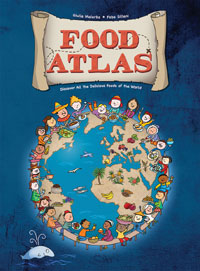| ________________
CM . . .
. Volume XXIV Number 15. . . .December 15, 2017

 |
Food Atlas: Discover All the Delicious Foods of the World.
Giulia Malerba. Illustrated by Febe Sillani. Translated by Sharon Morin.
Richmond Hill, ON: Firefly Books, 2017.
72 pp., hardcover, $19.95.
ISBN 978-1-77085-952-4.
Subject Headings:
Food habits-Juvenile literature.
Food-Juvenile literature.
International cooking-Juvenile literature.
Grades 3-6 / Ages 8-11.
Review by Gail Hamilton.
**½ /4 |
| |
|

excerpt:
Influenced by the temperate climate of the land and the gastronomies of the many English colonies, British cuisine is known for the use of potatoes, cereals, sauces and spices, such as curry. Cattle, sheep and pigs are raised throughout the country, from which many local cheeses and cured meats are produced. Among the most popular dishes are bacon and eggs, served at breakfast. Meat is also the star in dishes like stews and soups, and is the main ingredient in the fillings for savory pies.
An appealing cover and brightly patterned endpapers give readers a hint as to this book’s contents- a global tour of the main crops, animals and traditional dishes that are eaten in each of the 50 featured countries. Food Atlas begins with a large world map as its table of contents, indicating the countries included as well as examples of the kinds of symbols to be expected on the maps. Two of these symbols, a red and a blue star, represent a slow food presidium and a slow fish presidium, respectively. (A presidium is an organization whose mandate is to protect ecosystems that are at risk of extinction, to improve product quality and sustainability through stringent product standards, and to promote local consumption of specific foods. The goal is to ensure a viable future for traditional foods grown/caught in the area.)
Readers will likely forget to look for the coloured stars as they pore over the maps, and so, perhaps the stars could have been omitted altogether as they do not really add to the book.
Each country’s map is introduced by a short paragraph and is presented on either a single page or a double-page spread. In this regard, it might have been beneficial to put similarly shaped countries on pages opposite one another so that the reader does not have to turn the book. All of the maps’ land areas are rendered in pale green or dull beige, with the majority of the brighter colours coming from the little cartoon-like drawings of the plants, animals, spices, traditional dishes, desserts and beverages as well as the capital cities and points of interest. (The points of interest could have been eliminated altogether, for many of them, such as Argentina’s “La Boca” neighbourhood, will have no meaning to the reader.) Food symbols are usually shown in the part of the country where they are grown/raised/eaten, and the fish and seafood symbols in the surrounding waters. However, with so many symbols to place, the maps become quite crowded, and often the symbols for foods are shown in the ocean or within another country’s border, or very far away from their place of origin. One such example is the Halifax Donair, a kind of sandwich, whose symbol is printed in Greenland, nowhere near Halifax. The book ends with a world map showing food journeys, the country of origin of many common foods.
Food Atlas would benefit from a glossary as well as the inclusion of the pronunciation, in parentheses, of names of ethnic foods or dishes that are of another language. For instance, on the map of North America, there is mention of conquistadores and a dish called mole poblano, but nowhere are these terms defined or explained. Other examples of words and terms which could have been included in the glossary are truffles, rusk, artisanal, chitterlings, noble rot, and Vosges massif. Pronunciations for itäsuomenkarja (a Finnish cattle breed), pierniczki (traditional Polish Christmas spice cookies), éposses de bourgogne (a French cheese), and rote grütze (a German sweet dish made of berries and cherries), for example, would have been helpful.
Throughout the book there are fact boxes with interesting facts, anecdotes and a history of food names. One such story tells of a Nuremberg baker who healed his seriously ill daughter by baking a special cake using only the costliest ingredients. From that time, the type of cake he baked was named Elisenlebkuchen, after his daughter, Elizabeth.
Though Food Atlas is entertaining and educational, it is not without its minor flaws. It is large and unwieldy and very “busy”, with too many details, and the eye has a tendency to dart from one thing to another. It also lacks explanations for some of its inclusions, for example, why is Queso Chihuahua called “Mennonite cheese”? Are snow leopards really eaten in Mongolia, considering that the animals are endangered? And why include the Rocky Mountain Bighorn Sheep if, according to the author, it “has not been used for food for a long time”?
Generally speaking, however, Food Atlas is a book worthy of purchase for an elementary school library. Readers will not only learn where their food comes from, but they will also gain an appreciation for the many and varied culinary delights served around the world.
Recommended with Reservations.
Gail Hamilton is a former teacher-librarian in Winnipeg, MB.

© CM Association
CC BY-NC-ND
Hosted by:
University of Manitoba
ISSN 1201-9364
|
This Creative Commons license allows you to download the review and share it with others as long as you credit the CM Association. You cannot change the review in any way or use it commercially.
Commercial use is available through a contract with the CM Association. This Creative Commons license allows publishers whose works are being reviewed to download and share said CM reviews provided you credit the CM Association. |
Next Review | Table of Contents for This Issue - December 15, 2017.
CM Home | Back Issues | Search | CM Archive | Profiles Archive
|
